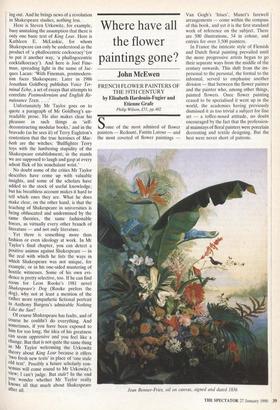Where have all the flower paintings gone?
John McEwen
FRENCH FLOWER PAINTERS OF THE 19TH CENTURY by Elisabeth Hardouin-Fugier and Etienne Grafe Some of the most admired of flower painters — Redoute, Fantin Latour — and the most coveted of flower paintings — Van Gogh's 'Irises', Manet's farewell arrangements — come within the compass of this book, and yet it is the first standard work of reference on the subject. There are 500 illustrations, 54 in colour, and entries for over 3,500 painters.
In France the intricate style of Flemish and Dutch floral painting prevailed until the more progressive artists began to go their separate ways from the middle of the century onwards. This shift from the im- personal to the personal, the formal to the informal, served to emphasise another division — that between the flower painter and the painter who, among other things, painted flowers. Once flower painting ceased to be specialised it went up in the world, the academies having previously dismissed it as too trivial a subject for fine art — a toffee-nosed attitude, no doubt encouraged by the fact that the profession- al mainstays of floral painters were porcelain decorating and textile designing. But the best were never short of patrons.
Jean Benner-Fries, oil on canvas, signed and dated 1836 Two Flemish-born artists particularly stamped their authority on French floral art: Gerard van Spaendonck and Redoute, who succeeded van Spaendonck as profes- sor of botanical drawing at the Paris Museum of Natural History. Redoutes brilliance as an artist was matched by his charm as a teacher, and he found favour at every court, from Marie Antoinette's to Louis Phillippe's. He had many female pupils and it was undoubtedly his influence that established flower painting in water- colours as a ladylike occupation.
Among the unfamiliar names here, it is those who paint in the style of Redoute - the likes of Marie Anne, Madame Benoit, Princesse Marie-Amelie-Francoise-Helene d'Orleans — who most catch the eye. But by mid-century there was a reaction against finesse. Even Redoute could be accused of 'waxiness'; and to this day one suspects that in arty circles he would not be consid- ered worthy of full-blown artistic status. By including painters who occasionally painted flowers this book may help banish such snobbery. As a contribution to the understanding of French art it is beyond reproach and my only grouse is that not all the colour plates are of sensational pictures.



























































 Previous page
Previous page